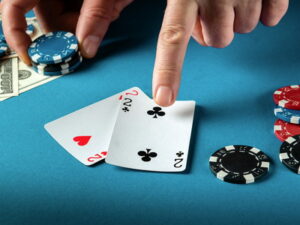How To Play Small Pocket Pairs In Poker
 When we talk about how to play small pocket pairs in a game of Texas Hold’em, we need to first agree on what is considered to be a smaller sized pocket pair. Generally speaking, a small pocket pair is regarded as being a pair that is ranging between 22 and 66. Anything above this, say 77 to AA, is considered to be a medium or high pocket pair.
When we talk about how to play small pocket pairs in a game of Texas Hold’em, we need to first agree on what is considered to be a smaller sized pocket pair. Generally speaking, a small pocket pair is regarded as being a pair that is ranging between 22 and 66. Anything above this, say 77 to AA, is considered to be a medium or high pocket pair.
Don’t be tricked into thinking that a small pocket pair is useless as they can be deceptively strong. However, be aware that these low pairs can also often lead novice players in to a lot of trouble when they are over valued. So long as an opponent is not holding a higher pocket pair, a smaller pocket pair is stronger than the majority of other hands pre flop. Post flop however, they can weaken if the hand has not improved. But, still, any pocket pair is welcome.
Small Pocket Pair Problems
There is a very high chance that the flop will deliver over cards when we are holding a small pocket pair. We will then have an under pair to the board meaning it is going to be highly difficult to try and find out if we are ahead or not. If we then make a bet which gets called, it gives us very little information on how strong we are.
In such a case, our opponent may be holding a drawing hand, a lower pair or any other possible hand. The straight forward bet and call will not inform us a whole lot about what hand our opponent is holding and it will likely prove costly if we attempt to try and find out if we are on top or not by betting on the turn and river.
Sets And Small Pocket Pairs

The true value of a low pocket pair is when they improve and make set on the flop. A set being when we make a 3 of a kind hand on the flop using our pocket pair. This is different to making a trip which is still 3 of a kind but made with just the one hole card and two community cards.
Sets can be very strong and because they are often hidden and it is possible to make a lot of money from them when they land because opponents will often not suspect them. Because of this, rather than looking to play a low pocket pair after the flop to try and find out if we are ahead or not, we should simply be looking to hit a set or make a fold.
It is very difficult and not very profitable to play a low pocket pair post flop if it does not improve so it is best to try avoid doing so. With low pocket pairs, the best strategy is always to attempt to make a set on the flop and then play on, obviously folding if the set doesn’t hit.
Mathematics And Pot Odds Of Hitting A set
So, what are the chances of flopping a set? Well, the odds of flopping a set with a pocket pair are 7/1. This means that we will hit a set one in every eight flops we see. To be honest, these are not particularly great odds and according to pot odds it will mean that we will unlikely to be getting decent enough odds pre flop to call in order to see a flop and hopefully make our set.
Basically, the pot odds suggest that we will be over paying for something that will not happen enough of the time make it worth it. However, there is there is some crucial information that we are omitting from our pot odds equation which is the implied odds that we have from hitting a set.
Implied Odds Can Make Playing Worth It
What are implied odds? Implied odds are simply how much we can expect to win after we make our hand. The implied odds that we have for sets are massive. It is common for players to lose all of their money to sets should they happen to catch a decent part of the flop. This is because players very rarely suspect that their opponent is holding one.
How To Play Small Pocket Pairs And Set Strategy
 When playing small pocket pairs, there are two main requirements we need to consider. The first is that our opponents should have relatively deep stacks, say around 70 BB+, anything over this and we should avoid calling raises in order to see a flop.
When playing small pocket pairs, there are two main requirements we need to consider. The first is that our opponents should have relatively deep stacks, say around 70 BB+, anything over this and we should avoid calling raises in order to see a flop.
The deeper our opponent’s stack is the better it is for us. This is because, as we have discussed, we are not going to hit a set very often. However, when we do hit that set we want to be rewarded accordingly. If our opponent has a small stack, the pay off for hitting our set and getting all in means that it won’t be worth us calling raises when we are only going to hit a set once in eight hands.
And because of this, the deeper the stack, the great the implied odds will be. This makes for a greater potential reward and the more expected value (+ EV) calling to hit a set becomes.
The larger the pre flop raise, the worse the pot odds become making it less profitable calling to hit a set over the long term. The usual pre flop raise, however, is around 3 or 4 BBs, which is decent enough for calling when attempting to hit a set. However, our implied odds after hitting a set are massive in which case we can afford to pay a little more in order to make it to the flop.
Generally speaking then, it is worth calling up to 7 BB raises pre flop for the simple reason that we can expect a nice juicy pay day when we hit that set. Be prepared to call up to 7 BB raises, or even a little more if the situation calls for it, with a small pocket pair. It might seem like quite a lot, but the returns are huge when you hit a set which makes it worth the effort.
Strong Post Flop Game
As long as your post flop game is strong, it can really pay off to with pocket pairs before the flop. Doing this would hand you the initiative in the hand and win you a few uncontested pots to go with with the bigger ones you took down when you hit your set.
That being said, for novice poker players just getting to grips with low pocket pairs, it will make it easier to call before the flop as opposed to raising. Both methods can be profitable and work for you so go with what you feel the most comfortable with and what works for you. When you raise pre flop with small pocket pairs it will be more + EV, but that is only so long as you know what it is you are doing.
Playing Small Pocket Pairs Summary
 Just to reiterate the importance of stack sizes, if an opponent has a short stack then our implied odds will decrease massively as there is going to be a great deal less for us to potentially win we hit our set. Likewise, should our opponents have big stacks then we will be getting brilliant implied odds for hitting our set. Basically, the smaller our opponent’s stack is, the lower our implied odds will be, and the bigger our opponent’s stack is, the greater our implied odds become.
Just to reiterate the importance of stack sizes, if an opponent has a short stack then our implied odds will decrease massively as there is going to be a great deal less for us to potentially win we hit our set. Likewise, should our opponents have big stacks then we will be getting brilliant implied odds for hitting our set. Basically, the smaller our opponent’s stack is, the lower our implied odds will be, and the bigger our opponent’s stack is, the greater our implied odds become.
This means that, when calling raises pre flop, we will have a little more wriggle room to work with. When your opponent has a short stack you should avoid calling raises and try to sneak in as cheaply as possible or possibly not even at all. But if your opponent has a big stack then you can afford to make the call for a little extra more in order to try and hit your set all because of the better implied odds.
By now, the importance of implied odds when playing small pocket pairs should really have been driven home. The implied odds are a critical part of the small pocket pair poker strategy so you should really try to familiarise yourself with them.



